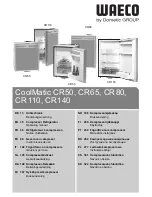
Defrosting
The surface of the evaporator ices up when the refrigerator is in normal use.
When the frost/ice layer reaches a thickness of 1/4", the refrigerator must be
defrosted and cleaned. Otherwise, lower efficiency and high energy
consumption will result.
1. Take out all food from the refrigerator and leave the door open.
2. Turn the thermostat to the OFF position,
0
, and unplug the refrigerator.
3. Position a shallow tray on the shelf below the chiller compartment.
4. After the ice has melted, dry the unit carefully and empty the drip tray.
5. Reconnect the power and set the thermostat to its original setting; close the
door.
6. Allow time for the unit to reach its normal temperature, then reload the food.
CAUTION: Using a sharp or metallic instrument to remove frost may damage the
cooling system and will void the warranty. We recommend using a plastic
scraper.
CARE AND MAINTENANCE
The refrigerator should be cleaned and maintained once a month. When
performing maintenance, make absolutely sure the power plug is first
disconnected from the power outlet.
Cleaning
Wipe the inner and outer surfaces of the refrigerator and its accessories with a
wet cloth. If necessary, use a solution of a mild detergent, then clean with water
and dry with a clean cloth.
When cleaning, do not use hot water, solvents, gasoline, alcohol, kerosene,
washing powder, abrasive cleansers, alkali detergents, etc., so as not to damage
the surface of the unit. Do not spray the refrigerator directly with water since this
could cause rust or damage the insulation.
Be especially careful to keep the sealing gasket around the inner surface of the
door clean.
If the plastic parts of the refrigerator remain contaminated for a long time by any
type of oil, they will age prematurely and possibly become subject to cracking.
The drainage pan at the back of the unit, above the compressor, should be
cleaned regularly.
9






























